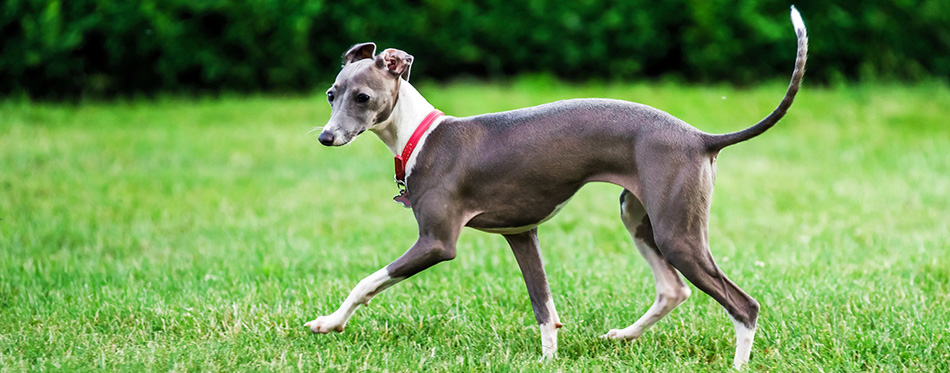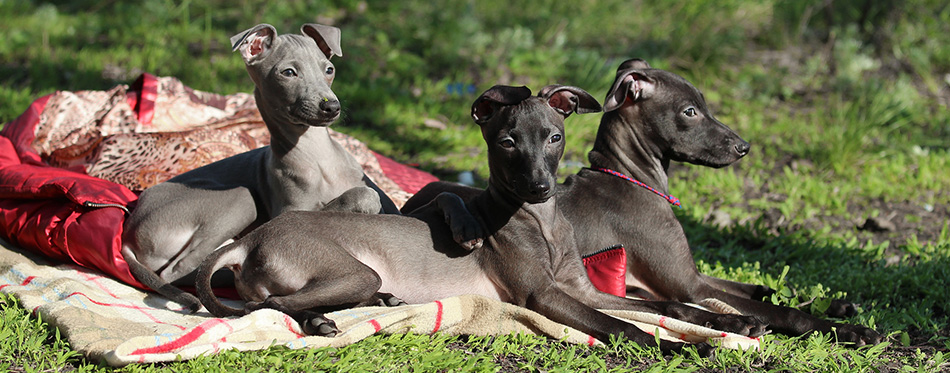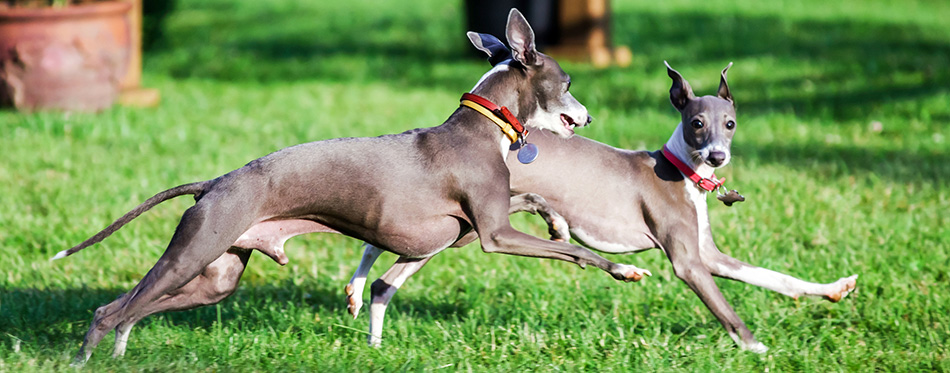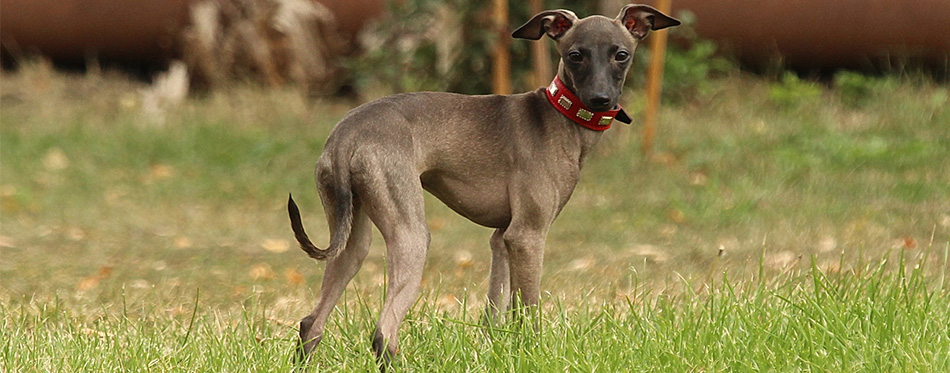Greyhounds are one of the most instantly recognizable dog breeds in the world. Their tall, skinny body and short coat are quite striking and memorable. While we might recognize them as commonly used racing dogs, the Greyhound breed has had a long and fascinating history spanning centuries! As they developed over time, they have had many interesting roles due to their athletic nature, but that doesn’t make them any less than the ideal pet. The Greyhound is a loving and loyal animal that loves to play and exercise with its owner.
Although they are known for being extremely physically active and one of the fastest animals on the planet, Greyhounds have also been endearingly referred to as the “45 mile per hour couch potato” which proves they love relaxing, too. So, if you’re looking to adopt a fun, sociable dog to exercise with but one who also enjoys relaxing on the sofa then the Greyhound might be the one for you! Or, maybe you’re just interested in learning some interesting facts about this fascinating breed. Either way, we’re sure you’ll learn something new about this fun-loving and loyal animal.

History of the Greyhound Breed
The Greyhound is widely believed to be one of the oldest dog breeds dating back to the Ancient Egyptians and Celts. However, scientists aren’t certain that Greyhounds (as we know them) existed at this time or if it was an ancestor or relative, instead. What they do know, is that the Ancient Egyptians have depicted animals very similar to the modern Greyhound from approximately 2,000 BC. Then from 500 BC, the Ancient Greeks also depicted Greyhound-type dog breeds. Both of these societies would paint noble, high-class citizens and religious figures/creatures so this implies Greyhounds were incredibly important animals. The Ancient Egyptians even mummified and buried their dogs with the rest of their family when they passed away. So, whether Greyhounds or their not-so-distant ancestors were kept as pets by ancient aristocracy, they were clearly deemed to be an important aspect of upper-class life.
Greyhounds weren’t exclusive to upper-class society however; they were kept by commoners too until the breed was almost wiped out by famine during the Middle-Ages. During this time, they were almost exclusively saved by clergymen who kept the breed safe and well-nourished for the sake of the nobility. Following the famine, the Greyhound became a pet and hunting dog exclusive to the upper-class and aristocracy. The breed was then governed and protected by law, meaning they could only be owned by aristocracy, kept in specific places and used to hunt in fields or forests which met specific legal requirements.
By the 1800s, the Greyhound breed had been bred and developed specifically for its athletic physique, incredible speed and loyalty which proved useful for training. During this century, the upper-class used Greyhounds for hare-chasing – a sport which became increasingly popular during this time and exploited the dog’s running ability. The breed also became popular for its looks and ability to learn complex skills, resulting in its appearance in dog shows. The breed was then recognized by the American Kennel Club (ACK) in 1885 thanks to its exponential growth in popularity during that century. By the mid-1920s, Greyhound racing had become a popular sport carried out in fields or tracks specifically designed for that sport.
Quick Facts About the Greyhound Dog
As you might just be learning about Greyhounds, here are some super-interesting facts we think you’ll appreciate about this brilliant breed.
- Greyhounds are the fastest dog breed in the world and can run up to 45 mph! Their consistent and reliable high-speed is the reason they are used for racing.
- Despite their athletic nature, Greyhounds can be very lazy! When they’re not running around breaking doggy word records for their speed, Greyhounds love to relax and sleep. They can spend most of their free time lying down, resting, sleeping or just generally being lazy. This is why they are known for being the “45 mile per hour couch potato.”
- Some people believe the Greyhound is a descendent of Anubis, the Ancient Egyptian God of Death and protector of the Afterlife. This belief stems from the fact that Anubis is depicted as human/wolf/hound-like creature, and because of the appearance of Greyhound-type dogs in Egyptian paintings and sculptures.
- Male and Female Greyhounds don’t differ too much in weight or height. An average adult Greyhound weights from 60 to 80 lbs and grows between 27 to 30 inches. However, males will typically weigh a few pounds more than females and usually grow one or two inches taller.
- The Greyhound’s coat is typically short and easy to maintain. It can vary in color from shades of grey, black, white, fawn, brindle or any combination of those colors.
- ‘Greyhound Lines’ (informally known as ‘Greyhound’) is a bus company in North America named after the dog breed for its famously fast speed. The company has even adopted the image of a sprinting Greyhound as its logo.
- The Greyhound breed prove why dogs are known as ‘man’s best friend.’ They have grown and developed alongside mankind and have been loyal companions throughout history. The breed is intelligent and physically active which make them perfect physical companions, while their affection, trust and friendliness make them comforting, emotional companions.

Things You Should Know About Greyhound
If you’re already convinced that you want to adopt one of these beautiful doggos then here are a few things you might want to know or at least consider.
Due to their short coat and lean bodies, Greyhounds shouldn’t typically be kept in cold climates or be made to sleep outdoors. Although they are best suited to mild-warm climates, they can get by in colder environments with the help of a dog coat. This is ideal not just for cold weather but also rainy or windy days when your dog might need a little more protection from the elements.
There are also several types of Greyhounds. As they have existed for a very long time and in almost every part of the world, they have developed into many sub-breeds which can only be found in specific locations. Here are examples of some of the many types of Greyhounds you might find: Russian Greyhounds (Borzoi), Afghan Greyhounds, Arabic Greyhounds (Sloughi), Scottish Greyhounds (Deerhounds) or the Whippet. Most types of Greyhounds will have specific characteristics or personalities which make them distinct and different to the other types. For example, the Scottish Greyhound shares a similar height, weight and coat color to the original Greyhound but it has longer, thick and scruffy coat. The Italian Greyhound is another type which is distinctly different to the original. This type of Greyhound has a similar physical build, coat color and length but is half the size of the original! While it might look the same proportionately, the Italian Greyhound grows up to a maximum of 15 inches and weighs a tiny 8-15 lbs. So, if you like the idea of having a Greyhound but aren’t in love with the coat color, length or size of the dog then have a look around at the various types. With so many types and options to consider, you’ll definitely find the Greyhound of your dreams.
Greyhound Dog Health
Greyhounds are generally quite healthy dogs that can go most (or all) of their lives without any problems as they aren’t prone to any medical conditions. However, there are a few conditions which can affect these animals regardless of genetics. These include gastric torsion, esophageal achalasia and bone cancer (osteosarcoma). While there aren’t any specific or main causes for these conditions, you can help decrease the risk by keeping your Greyhound dog fit and healthy with a balanced diet and exercise.
If you notice any soreness/tenderness, weakness, fatigue or a change in bodily functions or behaviors, you should inform your vet immediately. Noticing changes in your dog’s behavior, bodily processes or general symptoms which they don’t typically show, is the best way to catch any condition early and will give your dog the best chance they have of recovery.
Greyhound Training
Greyhounds can be quite tricky to train if you’re not entirely sure what you’re doing. For this reason, we suggest asking for professional advice if you’re unsure what to do as this is something you’ll want to get right. There are a few things however, that won’t change and are crucial you get right no matter how your Greyhound behaves. Due to their natural instincts to chase small prey, you should socialize Greyhound puppies with small animals and young children that also live in your house. Greyhounds will need to learn not to follow their instincts to chase small things, at least in your house. If you can, introduce your friends and family to your Greyhound while it’s young so it becomes used to meeting strangers. Greyhounds can be a little bit wary of strangers when they grow up, so regularly introducing them to new people could help them adapt to the situation.
As for other training, your Greyhound should learn just fine if you keep training sessions short and engaging. If you try to train your precious pup for too long, they will become bored and won’t retain the skills you’re teaching. Greyhounds are independent animals and can be quite challenging to train at times. Generally speaking, they like to do activities with you rather than for you so if you can incorporate this into your training, they might just pick it up quicker. Most importantly, Greyhounds require a gentle and encouraging approach to training as they respond best to this behavior – aggression should never be used. Remember to always reward your pooch with treats or toys whenever they successfully learn something new.

Greyhound Dog Exercise
You might have known that Greyhounds are exceptionally good runners before reading this article, or maybe you’ve just learned that. Either way, it shouldn’t be surprising that running or long walks are the ideal way to exercise these canine companions. It’s crucial that you put a leash on your Greyhound while you take them out in public. If not, they will run off, chasing anything smaller than them as this is their natural instinct. Unless you’re in a plain, open field where you can always see your dog, in a fenced area or unless they are well trained at recall, it’s generally not a good idea to remove the leash during exercise. While some dogs, particularly elderly ones, might prefer two short walks spaced throughout the day, some other dogs might be okay with just one exercise session per day. However, this exercise should be long and intense enough to satisfy the physical needs of your dog.
Greyhound Nutrition
Greyhound nutrition is quite simple. If you have an average-to-large sized adult Greyhound dog, they should receive 2 cups of dry food twice daily, plus some canned food or meat juices. Dogs which are smaller than average should receive just less than this, around 1.5 cups twice daily. While Greyhounds can survive on just dry dog food, you should make sure it is at least 20% protein and has little or no artificial flavors or colorings.
Some Greyhound parents might give a diet of raw meat and veg, while others might opt for mostly dry with some tinned meat or fish. Some dog parents might even make their own dog food from home! If you’re making your own dog food, be aware that not all human foods are dog friendly. Have a look online or ask your vet for a complete list of human foods which are safe/unsafe for your dog to eat. The most important thing is to strike a balance. Your Greyhound should have enough protein in their diet to maintain their weight and energy levels, but not too much as this could make them hyperactive. Similarly, if they lose weight you should increase the amount of food, or if they start to gain a few extra pounds, try feeding them a bit less or take them out to exercise more. Being a dog parent always involves some trial and error, so if you’re noticing weight fluctuations, try following this advice or seek professional advice from your vet.
For more guides on choosing the right dog food, you may wish to check out our reviews of the best dry dog food, organic dog food, grain free dog food, dog foods for sensitive stomachs and rawhide for dogs.
Greyhound Dog Grooming
Grooming your Greyhound might be the easiest aspect of caring for one of these perfect pups. As they naturally have a short coat, it will almost never need trimmed. However, you should brush their coat weekly to remove any shedding that takes place. Just like any other dog, your Greyhound will need their teeth and ears cleaned and their nails trimmed regularly – once a week should do it. It’s important to start this process while the dog is still young as Greyhound puppies will be easier to groom and they should become used to the process after a short while.
If you don’t do this regularly while the pup is young then it will most likely be challenging to do when they are older. Of course, you might not be able to control this if you’re adopting an older Greyhound but it’s worth finding out if they’re used to grooming. Although it might be a bit of a challenge to groom an untrained Greyhound, if you approach it carefully and with advice from a professional groomer or veterinarian, they might learn to accept the process…just a little later in life. If you aren’t comfortable grooming your dog, you can always arrange to take your dog to a salon every month so the remaining aspects of grooming can be carried out. Bathing with shampoo and conditioner, tick removal or anal gland expressing are all features of professional grooming which your dog might need. Alternatively, you could hire a mobile groomer to visit your home. When adopting a Greyhound, you should take them to the vet or speak to their previous owner if possible, to find out the regular grooming maintenance your dog might need. This will give you an indication of what you might be able to do yourself, and what you’ll have to hire a professional to do.
For more help on dog grooming, you may wish to read our guides on the best dog nail grinders, dog dryers, dog clippers, dog wipes, dog grooming clippers and dematting tools for dogs.

Greyhound Breed Temperament
Greyhounds really are the perfect pooch. They are intelligent and independent, yet gentle and caring. They can be a bit difficult to train and to exercise in the beginning because of their natural, instinctive urge to chase after smaller animals. However, through regular and encouraging training you should be able to deter this behavior. If a Greyhound is trained and socialized well during their puppy years, they should grow into loyal, well-behaved and eager-to-please adult doggos. You can expect a loyal and affectionate companion from the Greyhound as they love to play and exercise with their owner and their caring personalities mean you two can become the perfect pair.
Although the Greyhound might have connotations of an aristocratic or athletic dog, they can also be the perfect pet. Their intelligent, loving and caring personalities make them the ideal companion for any owner and their family.
Source:
- Greyhound – PetMD

